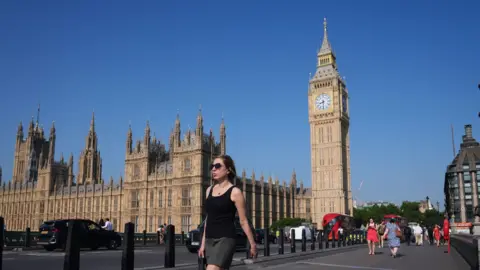The United Kingdom has recently experienced a significant milestone in its weather patterns, marking its hottest day of the year as temperatures soared past 30 degrees Celsius. An impressive peak of 30.1°C was recorded at St James’s Park in London, surpassing the previous record of 29.4°C observed in Suffolk just a week before on June 13. This increase in temperature comes amidst warnings of an imminent heatwave that is anticipated to push temperature higher, with forecasts suggesting that this weekend could see highs of 33°C.
Accompanying the warm weather, the UK Health Security Agency (UKHSA) has issued amber heat health alerts across the entirety of England. These alerts will remain in effect until 09:00 BST on the upcoming Monday, indicating that there will be heightened demands placed on health and social care services. The alerts serve as a caution against potential health risks and increased pressures on the services that care for the vulnerable.
Throughout Thursday, lower temperatures ranging from 27°C to 30°C are expected in areas spanning east Wales, the Midlands, and the East and South East regions of England. There are even projections of certain locations around Greater London and the home counties reaching temperatures of up to 31°C. Contrastingly, coastal areas are likely to offer a respite from the heat, with temperatures sitting around the 20°C mark. Before this sudden spike, parts of the UK had already been subject to yellow heat health alerts, as the country witnessed a series of high-temperature days.
The amber warning, inherently serious, infers that the entire health service could be adversely impacted by the soaring heat. The UKHSA notes possible difficulties in the management of medications and challenges faced by health workers in fulfilling their duties under such conditions. Additionally, there are concerns regarding care settings within the health system that may exceed internally recommended temperature thresholds throughout the heatwave. There is also an all-too-real fear that the heat could lead to an uptick in fatalities, particularly among seniors and those with existing health complications.
As temperatures continue to climb due to a high-pressure system across the UK, typical readings on Friday are expected to remain in the mid to high twenties, with parts of South East England likely to exceed the 30°C mark once again. However, reports suggest a cooling effect taking root for northern and western areas on Saturday, which may experience showers or thunderstorms, while central and eastern regions approach peak temperatures of between 30°C and 33°C.
The phenomena currently affecting the UK are a direct result of climatic changes that are swelling global temperatures, augmenting the possibility of extreme weather events. Prominent scientists have recently highlighted the pressing concern that the window to limit global warming to 1.5°C—a threshold established in the Paris Agreement of 2015—could close in as little as three years. This accord saw nearly 200 countries endeavoring to restrict temperature increases to prevent the most devastating impacts of climate change.
Historically, data shows that heatwaves are now believed to be thirty times more probable than they were before the industrial revolution, and projections suggest that they could occur biannually by the 2050s if greenhouse gas emissions continue to rise without restriction. Heightened public presence in coastal areas is anticipated as families seek relief from the heat, prompting local authorities to remind citizens of water safety amidst high temperatures. The London Fire Brigade has issued warnings regarding strong currents and the dangers associated with waterways, underscoring the necessity of safety education as warmer weather draws in more individuals towards outdoor recreational activities and waterways.
In this current climate of increased temperatures and health risks, a collective awareness and adherence to safety measures are critical to preserving public health and wellbeing through these challenging conditions.



